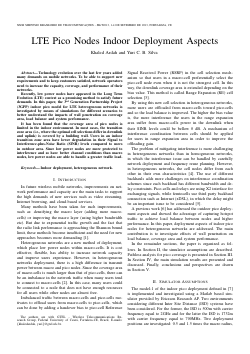
LTE Pico Nodes Indoor Deployment Aspects
Khaled Ardah, Yuri C. B. Silva
DOI: 10.14209/sbrt.2013.134
Evento: XXXI Simpósio Brasileiro de Telecomunicações (SBrT2013)
Keywords: Indoor deployment heterogeneous network.
Abstract
Technology evolution over the last few years added many demands on mobile networks. To be able to support new requirements and to keep customers satisfied, network operators need to increase the capacity, coverage, and performance of their networks. Recently, low power nodes have appeared in the Long Term Evolution (LTE) context as a promising method to satisfy future demands. In this paper, the 3 rd Generation Partnership Project (3GPP) indoor pico model for LTE heterogeneous networks is investigated by means of simulations for different scenarios to better understand the impacts of wall penetration on coverage area, load balance and system performance. It has been found that the coverage area of pico nodes is limited in the indoor environment. In most cases, the transition zone area (i.e., where the optimal cell selections differ in downlink and uplink) is covered by a building wall. Users in an indoor transition zone area have lower degradation in their Signal to Interference-plus-Noise Ratio (SINR) levels compared to users in outdoor area. Since low power nodes are more protected to interference and so have better channel conditions than macro nodes, low power nodes are able to handle a greater traffic load.Download